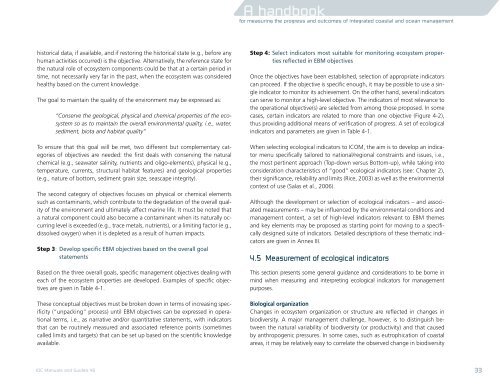5 - unesdoc - Unesco
5 - unesdoc - Unesco
5 - unesdoc - Unesco
You also want an ePaper? Increase the reach of your titles
YUMPU automatically turns print PDFs into web optimized ePapers that Google loves.
historical data, if available, and if restoring the historical state (e.g., before any<br />
human activities occurred) is the objective. Alternatively, the reference state for<br />
the natural role of ecosystem components could be that at a certain period in<br />
time, not necessarily very far in the past, when the ecosystem was considered<br />
healthy based on the current knowledge.<br />
The goal to maintain the quality of the environment may be expressed as:<br />
“Conserve the geological, physical and chemical properties of the ecosystem<br />
so as to maintain the overall environmental quality, i.e., water,<br />
sediment, biota and habitat quality”<br />
To ensure that this goal will be met, two different but complementary categories<br />
of objectives are needed: the first deals with conserving the natural<br />
chemical (e.g., seawater salinity, nutrients and oligo-elements), physical (e.g.,<br />
temperature, currents, structural habitat features) and geological properties<br />
(e.g., nature of bottom, sediment grain size, seascape integrity).<br />
The second category of objectives focuses on physical or chemical elements<br />
such as contaminants, which contribute to the degradation of the overall quality<br />
of the environment and ultimately affect marine life. It must be noted that<br />
a natural component could also become a contaminant when its naturally occurring<br />
level is exceeded (e.g., trace metals, nutrients), or a limiting factor (e.g.,<br />
dissolved oxygen) when it is depleted as a result of human impacts.<br />
Step 3: Develop specific EBM objectives based on the overall goal<br />
statements<br />
Based on the three overall goals, specific management objectives dealing with<br />
each of the ecosystem properties are developed. Examples of specific objectives<br />
are given in Table 4-1.<br />
These conceptual objectives must be broken down in terms of increasing specificity<br />
(“unpacking” process) until EBM objectives can be expressed in operational<br />
terms, i.e., as narrative and/or quantitative statements, with indicators<br />
that can be routinely measured and associated reference points (sometimes<br />
called limits and targets) that can be set up based on the scientific knowledge<br />
available.<br />
IOC Manuals and Guides 46<br />
A handbook<br />
for measuring the progress and outcomes of integrated coastal and ocean management<br />
Step 4: Select indicators most suitable for monitoring ecosystem properties<br />
reflected in EBM objectives<br />
Once the objectives have been established, selection of appropriate indicators<br />
can proceed. If the objective is specific enough, it may be possible to use a single<br />
indicator to monitor its achievement. On the other hand, several indicators<br />
can serve to monitor a high-level objective. The indicators of most relevance to<br />
the operational objective(s) are selected from among those proposed. In some<br />
cases, certain indicators are related to more than one objective (Figure 4-2),<br />
thus providing additional means of verification of progress. A set of ecological<br />
indicators and parameters are given in Table 4-1.<br />
When selecting ecological indicators to ICOM, the aim is to develop an indicator<br />
menu specifically tailored to national/regional constraints and issues, i.e.,<br />
the most pertinent approach (Top-down versus Bottom-up), while taking into<br />
consideration characteristics of “good” ecological indicators (see: Chapter 2),<br />
their significance, reliability and limits (Rice, 2003) as well as the environmental<br />
context of use (Salas et al., 2006).<br />
Although the development or selection of ecological indicators – and associated<br />
measurements – may be influenced by the environmental conditions and<br />
management context, a set of high-level indicators relevant to EBM themes<br />
and key elements may be proposed as starting point for moving to a specifically<br />
designed suite of indicators. Detailed descriptions of these thematic indicators<br />
are given in Annex III.<br />
4.5 Measurement of ecological indicators<br />
This section presents some general guidance and considerations to be borne in<br />
mind when measuring and interpreting ecological indicators for management<br />
purposes.<br />
Biological organization<br />
Changes in ecosystem organization or structure are reflected in changes in<br />
biodiversity. A major management challenge, however, is to distinguish between<br />
the natural variability of biodiversity (or productivity) and that caused<br />
by anthropogenic pressures. In some cases, such as eutrophication of coastal<br />
areas, it may be relatively easy to correlate the observed change in biodiversity<br />
33

















